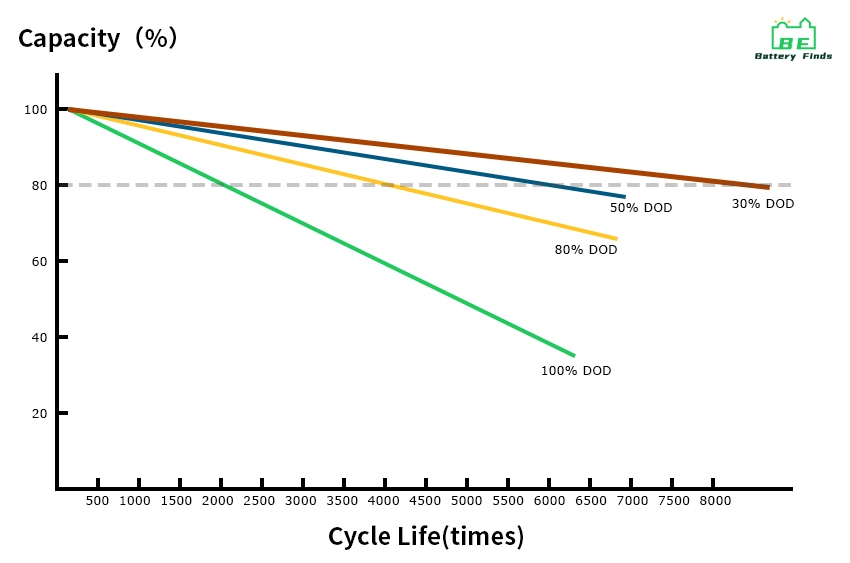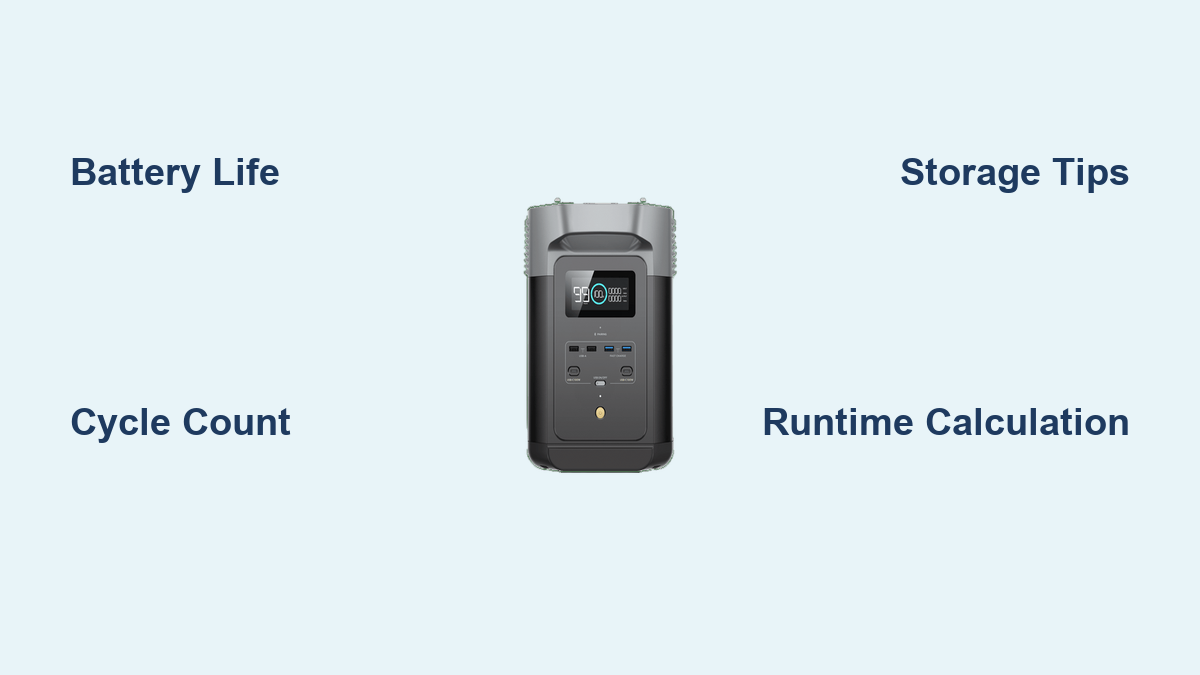Are you wondering how long your EcoFlow power station will actually last, and how to get the most out of its battery? It’s frustrating to invest in a portable power solution only to find its runtime significantly less than expected. A quick fix is to understand your power needs and adjust usage accordingly, but there’s much more to maximizing your EcoFlow’s lifespan.
This comprehensive guide will delve into the factors affecting EcoFlow power station lifespan, explain how to accurately estimate runtime based on your devices, and provide detailed strategies for extending battery health for years to come. We’ll cover everything from battery chemistry and storage best practices to firmware updates and troubleshooting common issues, ensuring you get the most out of your investment.
Understanding EcoFlow Battery Chemistry & Lifespan

EcoFlow primarily utilizes Lithium Iron Phosphate (LiFePO4) batteries in their power stations, known for their safety and longevity. However, all batteries degrade over time.
LiFePO4 vs. Traditional Lithium-ion Batteries
LiFePO4 batteries offer several advantages:
* Longer Lifespan: Typically 2,500-3,000 cycles to 80% capacity, compared to 500-1,000 cycles for traditional lithium-ion.
* Thermal Stability: More resistant to overheating and safer.
* Higher Discharge Rate: Can deliver more power consistently.
Factors Affecting Lifespan
- Cycle Count: Each charge and discharge cycle contributes to battery degradation.
- Depth of Discharge (DoD): Deeply discharging the battery (down to 0%) puts more stress on it than shallow discharges.
- Temperature: Extreme temperatures (hot or cold) accelerate battery degradation.
- Storage Conditions: Improper storage can significantly reduce lifespan.
- Charging Habits: Frequent fast charging can contribute to wear and tear.
Calculating EcoFlow Runtime: What to Expect

Accurately estimating runtime is crucial for planning and avoiding unexpected power outages.
Understanding Watt-Hours (Wh) and Watts (W)
- Watt-Hours (Wh): Represents the total energy capacity of your EcoFlow power station. (e.g., EcoFlow Delta 2 has 1024Wh)
- Watts (W): Represents the power consumption of your devices.
Runtime (hours) = Power Station Capacity (Wh) / Device Power Consumption (W)
Example Calculation
Let’s say you have an EcoFlow River 2 Pro (768Wh) and want to power a 60W laptop:
768Wh / 60W = 12.8 hours of runtime.
Inverter Efficiency & Real-World Usage
Inverter efficiency (typically 89-90%) means some energy is lost during conversion from DC to AC. Account for this:
Adjusted Runtime = (Power Station Capacity (Wh) x Inverter Efficiency) / Device Power Consumption (W)
Using the previous example, with 90% efficiency:
(768Wh x 0.90) / 60W = 11.52 hours of runtime.
Power Surges & Peak Loads
Some devices (like refrigerators or power tools) have a surge wattage that’s significantly higher than their running wattage. Ensure your EcoFlow can handle the surge, or it may shut down.
Maximizing Your EcoFlow’s Battery Health: Best Practices
Proactive maintenance and smart usage habits can dramatically extend your EcoFlow’s lifespan.
Charging Best Practices
- Avoid Full Charges & Discharges: Aim to keep the battery between 20% and 80% for optimal longevity.
- Use Slow Charging When Possible: If you don’t need a quick charge, use a standard AC outlet for slower, gentler charging.
- Avoid Charging in Extreme Temperatures: Charge within the recommended temperature range (typically 41°F to 104°F / 5°C to 40°C).
Storage Guidelines
- Ideal Storage Level: Store the EcoFlow at around 40-60% charge.
- Temperature Control: Store in a cool, dry place, away from direct sunlight and extreme temperatures.
- Regular Check-Ups: If storing for extended periods (months), check the battery level every 3-6 months and top it up if necessary.
Usage Tips
- Prioritize Essential Devices: Power critical appliances first, and limit the use of high-wattage devices.
- Use Energy-Efficient Appliances: LED lights consume significantly less power than traditional bulbs.
- Monitor Power Consumption: Use the EcoFlow app to track energy usage and identify power-hungry devices.
Troubleshooting Common Runtime Issues

If you’re experiencing shorter-than-expected runtime, these troubleshooting steps can help.
1. Battery Degradation
- Check Battery Health in the App: The EcoFlow app provides insights into battery health and cycle count.
- Calibrate the Battery: Follow the instructions in the EcoFlow app to calibrate the battery.
2. Inverter Issues
- Ensure Proper Ventilation: Overheating can reduce inverter efficiency.
- Check for Firmware Updates: Updated firmware can improve performance and stability.
3. Device Compatibility
- Confirm Wattage Compatibility: Verify your devices are within the EcoFlow’s wattage capacity.
- Avoid Reactive Loads: Some devices with motors (like refrigerators) can strain the inverter.
Pro Tips for EcoFlow Owners
- Utilize the EcoFlow App: Monitor battery health, customize charging settings, and control your power station remotely.
- Invest in Extra Batteries: Expand your capacity by adding extra batteries to compatible EcoFlow models.
- Consider Solar Charging: Supplement your power supply with solar panels for off-grid independence.
- Regularly Clean the Cooling Fans: Dust buildup can reduce cooling efficiency.
- Don’t Leave Devices in Standby: Many devices continue to draw power in standby mode.
When to Seek Professional Help
- Battery Swelling or Damage: Immediately discontinue use and contact EcoFlow support.
- Persistent Runtime Issues: If troubleshooting doesn’t resolve the problem.
- Inverter Failure: If the inverter isn’t functioning correctly.
- Warranty Concerns: If you believe your EcoFlow is covered under warranty.
FAQ
Q: How many years can an EcoFlow power station last?
A: With proper care, an EcoFlow power station using LiFePO4 batteries can last for 10+ years, delivering thousands of charge cycles.
Q: Can I leave my EcoFlow plugged in all the time?
A: While EcoFlow power stations have overcharge protection, it’s generally recommended to avoid leaving them plugged in constantly. Aim to charge as needed and keep the battery within the 20-80% range.
Q: What is the best way to store my EcoFlow for long periods?
A: Store at 40-60% charge, in a cool, dry place, and check the battery level every 3-6 months.
Q: Does temperature affect the lifespan of my EcoFlow?
A: Yes, extreme temperatures accelerate battery degradation. Avoid charging or using your EcoFlow in very hot or cold environments.
Get the Most Out of Your EcoFlow Power Station
By understanding your EcoFlow’s battery chemistry, accurately calculating runtime, and following these best practices, you can significantly extend its lifespan and enjoy reliable portable power for years to come. Don’t underestimate the importance of proper storage, smart charging habits, and regular maintenance.
Have you found these tips helpful? Share your EcoFlow experiences and any additional advice in the comments below!

